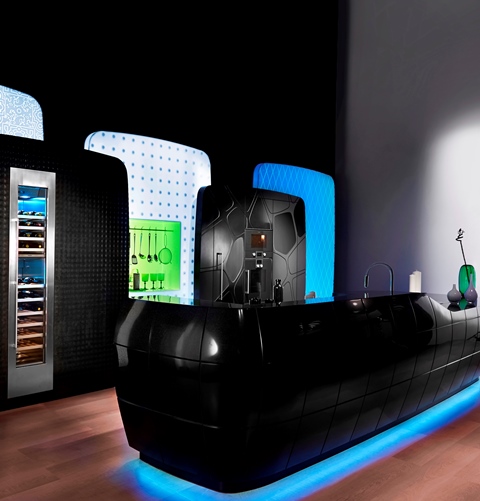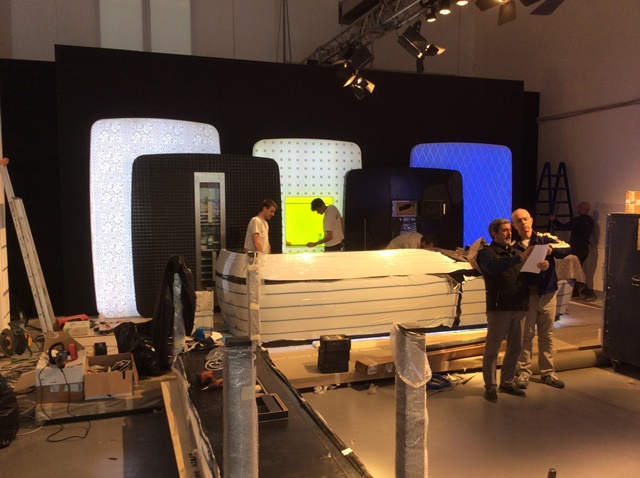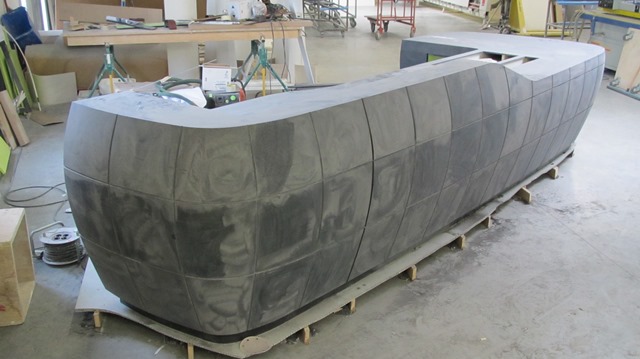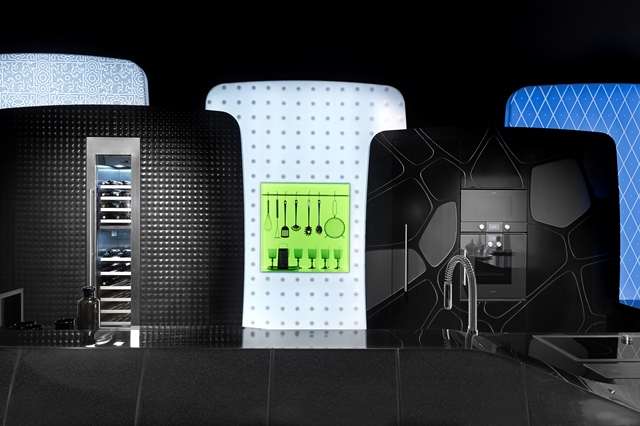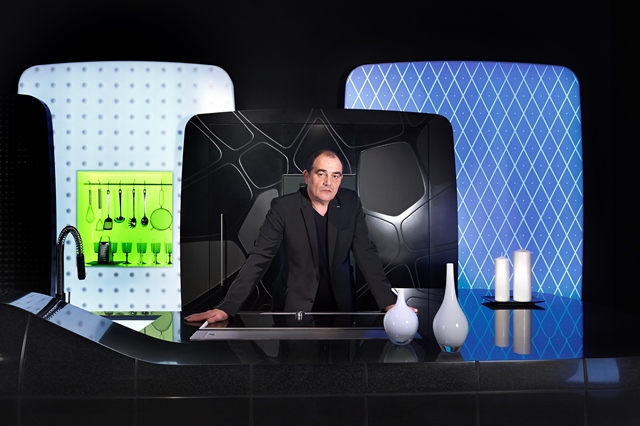Countertops Magazine ArchiveSolid Surface on Display: Mobile showroom highlights this material’s capabilities
Super Black kitchen made with DuPont™ Corian®, created for “Corian® 2.0” exhibition (Milan, April 2014); design Christian Ghion, production Créa Diffusion; photo Leo Torri for DuPont™ Corian®; all rights reserved on design and photo. When Jean-Yves Bach, the European manager for DuPont™ Corian®, decided to participate in the Milan Furniture Fair he wanted a display that would not only be spectacular to view, but would show off the expanding capabilities of Corian solid surface. Who better to bring on board for the project than famous French designer Christian Ghion? And so that is what he did.
The overall project was to be called “Corian 2.0” and would basically be a showroom that could be assembled at the event and would feature three separate components, a kitchen, a bathroom and a lounge. The overall idea was to combine innovative solutions for our increasingly digital society with the high quality design capable with solid surface and top class furnishings. The project was to feature the fascination of translucency with advanced lighting and electronic systems in a way that also showcased the company’s new and exclusive manufacturing process, the DeepColor™ Technology.
The result is a design exhibition demonstrating the evolutionary capabilities of DuPont Corian and its ability to adapt to the new demands of society, and to interpret the best ideas coming from the industry and creative minds.
The Men behind the Design Born in 1958 in France, Ghion earned a law degree before deciding to study design. He graduated in 1987 from the Ecole Nationale Supérieure de la création industrielle (ENSCI) and went on to win the prestigious “Grand Prix de la création de la ville de Paris” in 1990. His unique designs and artistic vision that focuses on imaginative functionality has since led him to work for a variety of well-known furniture manufacturers. His successes have driven his work to now be found in such honorific locales as the Musée des Arts Décoratifs and the Centre Georges Pompidou in Paris, as well as the Guggenheim Museum New York. It is these laurels that made him the top choice for designing the solid surface display. When employed to develop a concept for the display, Ghion knew just who to turn to for assistance – renown European fabricator Thierry Delles of Créa Diffusion. Créa Diffusion has among its conquests some of the most complex and unique solid surface projects in the world, including work at the Palace of Versailles, the headquarters of the European Investment Bank in Luxembourg and cladding the entire exterior of the Abidjan Convention Center in the Ivory Coast of Africa, just to name a few.
Ghion and Delles had worked together in the past on other solid surface projects and had established not only a successful business relationship, but also a friendship. Bach had also worked with Delles and knew how adept his operation was, so when they turned to him for assistance, it was a perfect match both in capabilities and personalities.
Getting Started After an initial meeting to discuss the project, see the prototype of the new colors that DuPont was introducing and layout the parameters, Delles found himself a bit surprised when Ghion asked to come to his shop to look around and get a “little refresher course” on solid surface and the equipment in the workshop. Delles knew Ghion was very familiar with both his company and the properties of solid surface, but was impressed to have a designer that was so interested in all of the intimate details of the fabrication processes and equipment.
“First thing , Ghion went to the waste containers, found some small scraps from previous jobs, some of which had intricate etchings and reliefs, and began to study them,” explained Delles. “He looked at them from above, below, on the side, under the light and asked how the work was done and if the projects they were used in were successful. He wanted the operations of each machine explained and asked why a particular thing was done. It was almost like a child exploring. He liked to see, to feel and even to smell all the possibilities of the material with one obsession - to not lose something that could feed his creativity.”
After the tour of the shop, which included in-depth looks at Créa’s custom products shop, industrial products area and molding and thermoforming area, Ghion left with the inspiration he needed to formulate a design. Two weeks later he phoned Bach and Delles to offer four completely different project options. Bach was very excited, Delles was a little bit less so. The work was definitely complex and used shapes that could be could be very difficult to create. However, Delles was up to the challenge and together, the three discussed the options and selected one of the proposals.
The selected design, which encompassed all three of the required areas, included an eye-catching kitchen space dominated by a wonderful kitchen island with multi-functional wall system entirely fabricated in solid surface. Called “Super Black,” the kitchen incorporates high quality appliances by Gaggenau, a special wireless smartphone recharger from Powermat Technologies also offering networking capabilities, functional hardware for cabinets from Blum and a tap made by Fir Italia.
The bathroom space use elegant furnishings and accessories designed and produced in solid surface that also incorporated the wireless recharging system and proposing a beautiful backlit solid surface wall that featured intricate engraved relief patterns.
The third, lounge space focused on a new decorative solution for interior environments - the Ambium® Dynamic LEDwall by Koledo - combined with furnishings from Moroso, also including several solid surface products. This space also proposed a new solid surface bar table concept called “Blackground.” The table is characterized by a bold black and white pattern, includes Powermat’s devices for wireless recharging and operates as a virtual computer thanks to a system by Connecting Technology.
Because of the size of the project and the limited timeframe to complete it (about 6 weeks from start to completion), additional fabricators would have to be brought in to handle the various pieces and applications.
While Créa Diffusion assisted with portions of the other two parts of the project, its main focus was on the Super Black kitchen display, which it handled completely. The bathroom was mainly fabricated by Rexa Design, with Créa doing the backlit wall. And the lounge area was through a combination of efforts by three fabricators: Gielisssen, which fabricated the LEDwall; TechLab Italia, which fabricated various solid surface furnishings; and Créa, which built the solid surface bar table.
Fabrication Challenges in the Kitchen With most of his efforts focused on the Super Black kitchen, Delles and his crew dove right in and made the project their own.
Over a six-week period, 33 sheets of solid surface were cut, thermoformed, engraved, joined and backlit for this project which took 1,365 man-hours to fabricate.
“The first step when you have this kind of work is to understand the essential spirit of the project and main message the designer wants to convey,” explained Delles. “We are not here to change the design of a project like this. After understanding the project, we must adapt our work to make it a reality.”
And while Créa Diffusion is well versed in adapting to these types of projects, it wasn’t without its difficulties. The main issues that had to be overcome were the complex engraving, the use of dark colors and the dynamic shapes prescribed by the design.
When it came to the engraved vertical surfaces, Créa definitely had the upper hand, having performed and perfected this sort of work in the past. “The different patterns were inspired from other works that Créa Diffusion had done previously, like one of the walls in the Palace of Versailles, a facade done in Paris and another from a bathroom in Côte d’Azur (the French Riviera) in the south of France,” said Delles. “Overall, there were six different relief aspects; some were created by an engraving CNC process, while others were made using double-mold thermoforming.”
However, the design called for these panels to really stand out boldly, so adapting the engraving process to the patterns called for was just the first step in the process.
“One of Ghion’s main ideas was to mingle the dark and the light, so we used LEDs to back light colored translucent panels which gave more relief to the engraving,” explained Delles.
Another challenge, which Delles thought would be the toughest going into the project, was the fact that all of the main pieces of furniture were designed using varying shades of black Corian: Deep Nocturne, Deep Night Sky, Deep Black Quartz and Deep Anthracite. “Darker colors do not have a good reputation as being easy to work with,” he explained. “They tend to show imperfections easier and are historically tougher to thermoform. And when a company works [on a project] for a show, that means it is exposed the eyes of its colleagues and before its competitors and critics, leaving no room to fail!”
Additionally, the design called for the worktop to be sanded to a high-gloss finish, which is typically tougher on black solid surface, and the finish would have to hold up to a lot of exposure to large crowds at the show – not an easy prospect.
Prior to this project nobody had worked with the new Deep Colors technology. The idea behind the technology was that darker colors would be more durable and less prone to show wear because of a technique used in the manufacturing process. This technique made for material that, when scratched, would scratch dark instead of white like typical dark colors of solid surface. So, the new colors were an untested variable to the fabrication team.
“The solid surface sheets had to be thermoformed into a difficult 3-D shapes, and the colors were new for us and untested,” said Delles. But that didn’t stop him in the least. A CNC machine was used to make the thermoforming molds and both vacuum and hydraulic presses were used to thermoform the sheets. Much to Delles pleasant surprise, the thermoforming was able to be performed without any whiteness creeping into the areas that were heated and formed.
“This new black Deep Color Technology gave us very, very nice results,” shared Delles. “They were easier to glue, producing totally invisible seams and we were able to sand them to a high gloss.”
The Créa Diffusion team had to refine the sanding process to allow for the exposure the furniture would receive from the public, and the sanding time to reach a high gloss had to be increased, but the end result impressed even Delles. “When all is said and done, I am a fabricator with no preference of brand, but I can say that this new technology, DCT, brings more to this special type of project, and we did other work with this material since this project with the same success.”
While hardly boasting that a project of this complexity was easily performed, Delles did give much of the credit to the skills of Créa’s team, who put in a total of 1,365 man-hours over the course of six weeks.
The project took a total of 33 sheets of material – 20 sheets of standard ½-in. material, 8 sheets of ¼-in. material and five sheets just to perform testing on to refine the techniques used. And when it was finished, it would certainly face scrutiny by both the designer who had envisioned it and by the public who would see it first-hand in Milan.
The multi-functional wall system (from left to right) included backlit Glacier Ice; Deep Black Quartz; Glacier Ice with a niche in backlit Lime Ice; Deep Anthracite; and backlit Blueberry Ice Corian.
The Finished Product The completed kitchen featured an island base made of Deep Nocturne, a top made of Deep Night Sky and a backlit sink in Glacier Ice Corian. The multi-functional wall system included backlit Glacier Ice; Deep Black Quartz; Glacier Ice with a niche in backlit Lime Ice; Deep Anthracite; and backlit Blueberry Ice Corian. And it all came together exquisitely.
Ghion was extremely happy with the finished results and seeing his vision of the Super Black kitchen come together through the hard work of the Créa Diffusion team. “In this shrine-like environment, the kitchen embodies and further reinforces the aesthetic qualities and new potential - in terms of formability, engraving and resistance - of the black colors of Corian made with the DeepColor Technology,” said Ghion. “The fundamental idea: invite the visitor to see the kitchen with new eyes, the kitchen becomes the ‘choir.’ Like mountains over-shadowing valleys, both black and translucent panels dominate over the rounded, sensual and generous forms of the island. Light creates relief effects, inviting one to look and touch.”
And the bathroom and lounge areas were no less impressive in his eyes.
“The bathroom space is like a treasure-chest, at the same time majestic and delicate, characterized by the contrast of black and white Corian,” he said. “A white wall, finely decorated and backlit, intensifies the entire display.”
Ghion likened the lounge area “to a space suspended between the material and the digital, the real and the virtual world” with wireless recharging and Internet connectivity mingled with a backdrop of large solid surface panels that project video images in harmony with the lounge. “In this universe, all the elements concur to demonstrate the material performance associated with different electronic and lighting solutions,” he said.
Famous French Designer Christian Ghion shows off the culmination of his design skills and Créa Diffusion’s fabrication skills in the form of the “Super Black” kitchen display at the Milan Furniture Fair. End Results In the end, all three of the prominent figures in the project – Ghion, Delles and Bach – had something they could really be proud of that accomplished the goals set forth on time and on budget. However, the real proof of success was how it was received by the professionals attending the fair, and that did not disappoint.
The DuPont booth registered one of the largest number of visitors ever at its booth and quite a buzz was created among the design and fabrication community, who commented how the project was not only aesthetically appealing, but also advanced the market.
Because of its success in Milan, it was decided that the display should be taken to other shows across Europe, including the 100% Design Fair in London and the Fair Interior in Courtrai, Belgium, where it received equal fanfare. One attendee of the expo in Belgium even inquired about buying the kitchen and having it adapted to his flat in Brussels!
When all was said and done, the objectives were met spectacularly in a way that showcases applications of the new DeepColor tones of Corian, while combining devices for the wireless charging and networking of smartphones with the design capability of solid surface. This enabled visitors to better understand the meaning of smart surfaces, and directly experience solutions that will become increasingly popular in daily life. But, this may only be the beginning.
"We are far from having extracted [Corian’s] full potential and there are many new application fields that remain to be explored through our collaboration with industry and creative minds,” concluded Bach.
For more information on Christian Ghion, visit www.christianghion.com.
For more information on Créa Diffusion, visit www.crea-diffusion.com.
For more information on Corian® 2.0, visit www.corian2-0.com. A video about the Super Black kitchen and Corian® 2.0 exhibition can be viewed at http://youtu.be/HqlMQ-ULceE.
Editor and Publisher Kevin Cole can be reached at [email protected]. |

